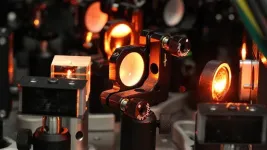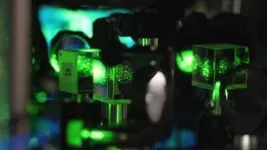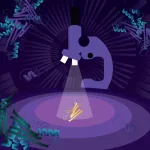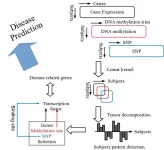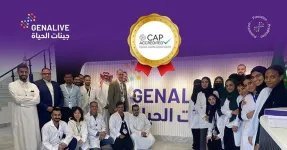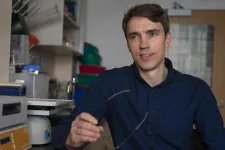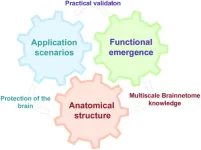(Press-News.org) Researchers have developed a method that can reveal the location of errors in quantum computers, making them up to ten times easier to correct. This will significantly accelerate progress towards large-scale quantum computers capable of tackling the world’s most challenging computational problems, the researchers said.
Led by Princeton University’s Jeff Thompson, the team demonstrated a way to identify when errors occur in quantum computers more easily than ever before. This is a new direction for research into quantum computing hardware, which more often seeks to simply lower the probability of an error occurring in the first place.
A paper detailing the new approach was published in Nature on Oct. 11. Thompson’s collaborators include Shruti Puri at Yale University and Guido Pupillo at Strasbourg University.
Physicists have been inventing new qubits — the core component of quantum computers — for nearly three decades, and steadily improving those qubits to be less fragile and less prone to error. But some errors are inevitable no matter how good qubits get. The central obstacle to the future development of quantum computers is being able to correct for these errors. However, to correct an error, you first have to figure out if an error occurred, and where it is in the data. And typically, the process of checking for errors introduces more errors, which have to be found again, and so on.
Quantum computers’ ability to manage those inevitable errors has remained more or less stagnant over that long period, according to Thompson, associate professor of electrical and computer engineering. And he realized there was an opportunity in biasing certain kinds of errors.
“Not all errors are created equal,” he said.
Thompson’s lab works on a type of quantum computer based on neutral atoms. Inside the ultra-high vacuum chamber that defines the computer, qubits are stored in the spin of individual ytterbium atoms held in place by focused laser beams called optical tweezers. In this work, a team led by graduate student Shuo Ma used an array of 10 qubits to characterize the probability of errors occurring while first manipulating each qubit in isolation, then manipulating pairs of qubits together.
They found error rates near the state of the art for a system of this kind: 0.1 percent per operation for single qubits and 2 percent per operation for pairs of qubits.
However, the main result of the study is not only the low error rates, but also a different way to characterize them without destroying the qubits. By using a different set of energy levels within the atom to store the qubit, compared to previous work, the researchers were able to monitor the qubits during the computation to detect the occurrence of errors in real time. This measurement causes the qubits with errors to emit a flash of light, while the qubits without errors remain dark and are unaffected.
This process converts the errors into a type of error known as an erasure error. Erasure errors have been studied in the context of qubits made from photons, and have long been known to be simpler to correct than errors in unknown locations, Thompson said. However, this work is the first time the erasure-error model has been applied to matter-based qubits. It follows a theoretical proposal last year from Thompson, Puri and Shimon Kolkowitz of the University of California-Berkeley.
In the demonstration, approximately 56 percent of one-qubit errors and 33 percent of two-qubit errors were detectable before the end of the experiment. Crucially, the act of checking for errors doesn’t cause significantly more errors: The researchers showed that checking increased the rate of errors by less than 0.001 percent. According to Thompson, the fraction of errors detected can be improved with additional engineering.
The researchers believe that, with the new approach, close to 98 percent of all errors should be detectable with optimized protocols. This could reduce the computational costs of implementing error correction by an order of magnitude or more.
Other groups have already started to adapt this new error detection architecture. Researchers at Amazon Web Services and a separate group at Yale have independently shown how this new paradigm can also improve systems using superconducting qubits.
“We need advances in many different areas to enable useful, large-scale quantum computing. One of the challenges of systems engineering is that these advances that you come up with don't always add up constructively. They can pull you in different directions,” Thompson said. “What’s nice about erasure conversion is that it can be used in many different qubits and computer architectures, so it can be deployed flexibly in combination with other developments.”
Additional authors on the paper “High-fidelity gates with mid-circuit erasure conversion in a metastable neutral atom qubit” include Shuo Ma, Genyue Liu, Pai Peng, Bichen Zhang, and Alex P. Burgers, at Princeton; Sven Jandura at Strasbourg; and Jahan Claes at Yale. This work was supported in part by the Army Research Office, the Office of Naval Research, DARPA, the National Science Foundation and the Sloan Foundation.
END
Illuminating errors creates a new paradigm for quantum computing
With a quick pulse of light, researchers can now find and erase errors in real time
2023-10-11
ELSE PRESS RELEASES FROM THIS DATE:
Disparities persist across levels of surgery department leadership in US
2023-10-11
PHILADELPHIA – Women and those from racial and ethnic groups underrepresented in medicine (URiM) not only occupy few leadership roles in surgical departments but also tend to be clustered into certain leadership roles, according to a new analysis led by researchers from the Perelman School of Medicine at the University of Pennsylvania. These clusters of roles include vice chairs of diversity, equity, and inclusion (DEI) or wellness, where the promotion path to department chair is unclear. The report was published today in JAMA Surgery and led by ...
An AI tool that can help forecast viral outbreaks
2023-10-11
At a glance:
New AI tool called EVEscape uses evolutionary and biological information to predict how a virus could change to escape the immune system.
The tool successfully predicted the most concerning new variants that occurred during the COVID-19 pandemic.
Researchers say the tool can help inform the development of vaccines and therapies for SARS-CoV-2 and other rapidly mutating viruses.
The COVID-19 pandemic seemed like a never-ending parade of SARS-CoV-2 variants, each equipped with new ways to evade the immune system, leaving the world bracing for what would come next.
But what if there were a way to make predictions ...
Doubling down on known protein families
2023-10-11
Imagine researchers exploring a dark room with a flashlight, only able to clearly identify what falls within that single beam. When it comes to microbial communities, scientists have historically been unable to see beyond the beam — worse, they didn’t even know how big the room is.
A new study published online October 11, 2023 in Nature highlights the vast array of functional diversity of microbes through a novel approach to better understand microbial communities by looking at protein function within them. The work was led by a team of scientists at the U.S. Department of Energy ...
Detection and extraction of similar features in the disease-related gene groups
2023-10-11
【Research Study】
1. Background
Multiomics3 analysis that integrates different layers of profiles altogether is challenging, since the number of variables in profile substantially differ from each other. For instance, gene expression profile and genomic DNA methylation profile are often analyzed together, however, there are only tens of thousands of genes, whereas the number of DNA methylation sites are as many as tens of millions. The numbers differ one thousand times and the number ...
Omega-3 discovery moves us closer to 'precision nutrition' for better health
2023-10-11
University of Virginia School of Medicine researchers have obtained new insights into how African-American and Hispanic-American people’s genes influence their ability to use Omega-3 and Omega-6 fatty acids for good health. The findings are an important step toward “precision nutrition” – where a diet tailored to exactly what our bodies need can help us live longer, healthier lives.
Omega-3 and Omega-6 are “healthy fats.” We can get them from foods, but many people also take ...
Genalive earns CAP accreditation to raise the bar for clinical standards in Saudi Arabia
2023-10-11
Genalive, a leading clinical laboratory in Saudi Arabia, has passed an audit organized by the College of American Clinical Pathologists (CAP), demonstrating its excellence in clinical laboratory testing and management practices.
Genalive officially opened in June 2023, equipped with high-throughput sequencing platforms, advanced bioinformatics pipelines, AI-driven analytical tools and staffed by a team of experienced medical professionals and technicians. Genalive is a joint venture between BGI Almanahil Health for Medical Services, a wholly owned subsidiary of BGI Genomics, and Tibbiyah Holding, a renowned Saudi healthcare ...
Gene discoveries could help prevent deadly coronary artery disease
2023-10-11
An international team of scientists has identified nearly a dozen genes that contribute to calcium buildup in our coronary arteries that can lead to life-threatening coronary artery disease, a condition responsible for up to one in four deaths in the United States. Doctors may be able to target these genes with existing medications – or possibly even nutritional supplements – to slow or halt the disease’s progression.
“By sharing valuable genotype and phenotype datasets collected over many years, our team was able to uncover new genes that may foreshadow clinical coronary artery disease,” said researcher Clint L. Miller, PhD, of ...
Journal honors pioneering scientist with new series
2023-10-11
While scientific advances are made daily, foundational breakthroughs are rare and require exceptional researchers with unique points of view and questions, plus the necessary means to explore those ideas. One such researcher, Harold H. Flor, became a seminal figure in the study of plant pathology after developing the gene-for-gene concept in the mid-1900s. The gene-for-gene concept (namely, for each gene governing the host response, there is a corresponding gene in the pathogen) still stands as one of the most significant contributions to plant pathology—forever changing how scientists approach plant-microbe interactions and, more specifically, the molecular mechanisms ...
SwRI selected for $1.5 million DOE grant to evaluate compressor system for hydrogen-natural gas blends
2023-10-11
SAN ANTONIO — October 11, 2023 —Southwest Research Institute has been selected to receive a $1.5 million contract from the U.S Department of Energy to evaluate the safety and efficiency of a full-scale compressor system for hydrogen-natural gas blends containing up to 20 percent hydrogen by volume. SwRI will collaborate with the Gas Machinery Research Council (GMRC) on this project.
“Hydrogen has been recognized as a viable alternative to natural gas fuel,” said SwRI Senior Research Analyst Sarah Simons. “However, a pure hydrogen stream is not compatible with existing energy transport infrastructure because hydrogen and natural gas have ...
Researchers plot a course for building a “digital twin” of the brain
2023-10-11
Recent developments in neuroscience and brain-inspired artificial intelligence have opened up new possibilities in understanding intelligence. Now, a research team led by Tianzi Jiang at the Institute of Automation of the Chinese Academy of Sciences has outlined the key components and properties of an innovative platform called the Digital Twin Brain, which could bridge the gap between biological and artificial intelligence and provide new insights into both. This research was published Sept. 22 in Intelligent Computing, a Science Partner Journal.
Network structure is something that biological and artificial intelligence have in common. Since the brain consists ...
LAST 30 PRESS RELEASES:
Kennesaw State University’s Jerry Mack named Paul “Bear” Bryant Newcomer Coach of the Year
Ancient teeth are treasure troves of data on Iron Age lifestyles
Avocados may become easier to grow in India—but not if global emissions remain high
Pregnant women with IBD show heightened inflammation in vaginal mucosa
Underwater photos show seabirds, seals and fish interacting with a tidal turbine in Washington State
1 in 5 surveyed UK adults who have experienced the death of a pet report it as more distressing than experienced human deaths, with significant rates of prolonged grief disorder symptoms also being re
Polyester microfibers in soil negatively impact the development of cherry tomato plants in experiments, raising concerns over the potential effect of high levels of such contaminants
LGBTQ+ adults may be around twice as likely to be unemployed or to report workforce non-participation compared to heterosexual adults, per large representative Australian survey
Horses can smell fear: In experiments where horses smelled sweat from scared humans, they reacted to scary and sudden events with increased fear and reduced human interaction
New synaptic formation in adolescence challenges conventional views of brain development
Scientists identify target to treat devastating brain disease
Oliver Zielinski selected as Fellow of The Oceanography Society
Has progress stalled on gender equality at work?
Quantum simulator sheds light on how nature moves energy in systems like photosynthesis and solar conversion
Can a hashtag help prevent atrocities? Study shows social media can be a powerful tool
The American Ornithological Society (AOS) announces the winner of the 2025 Wesley Lanyon Award
Woolly rhino genome recovered from Ice Age wolf stomach
An earthquake on a chip: New tech could make smartphones smaller, faster
New research shows how AI tools are expanding individual capabilities while contracting scientific attention
A nanomaterial flex — MXene electrodes help OLED display technology shine, while bending and stretching
Global research team uncovers mechanism by which metabolites guide cellular decisions
Work hours, stress, and burnout among resident physicians
Quality of life of parents of premature infants
Should younger and older people receive different treatments for the same infection?
Scientists discover how fast the world’s deltas are sinking
Scientists demonstrate first-time use of AI for genetic circuit design
Copenhagen researchers make the front page of Nature: Solving the mystery of the universe's ‘little red dots’
Seoul National University-Drexel University team achieves world's highest efficiency fully stretchable OLEDs with 17% external quantum efficiency
Hydrogel cilia set new standard in microrobotics
Application of orthogonal CNOP-I in a convection-allowing ensemble prediction system based on CMA-MESO for improving extreme precipitation skill
[Press-News.org] Illuminating errors creates a new paradigm for quantum computingWith a quick pulse of light, researchers can now find and erase errors in real time
